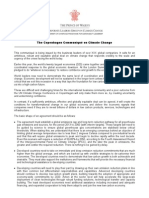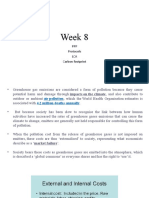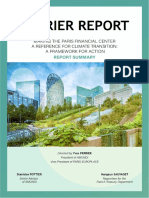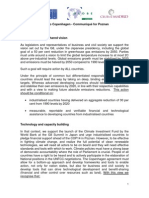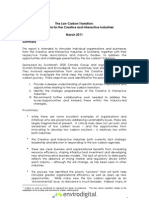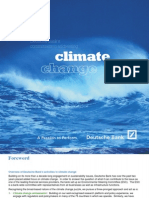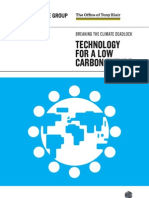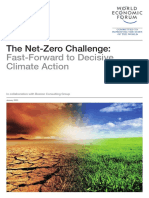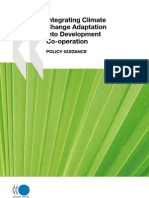Texto Completo Del Tratado de Copenhague Contra El Cambio Climático (Apoyado Por 500 Multinacionales)
Texto Completo Del Tratado de Copenhague Contra El Cambio Climático (Apoyado Por 500 Multinacionales)
Uploaded by
Informativos.NetCopyright:
Available Formats
Texto Completo Del Tratado de Copenhague Contra El Cambio Climático (Apoyado Por 500 Multinacionales)
Texto Completo Del Tratado de Copenhague Contra El Cambio Climático (Apoyado Por 500 Multinacionales)
Uploaded by
Informativos.NetOriginal Title
Copyright
Available Formats
Share this document
Did you find this document useful?
Is this content inappropriate?
Copyright:
Available Formats
Texto Completo Del Tratado de Copenhague Contra El Cambio Climático (Apoyado Por 500 Multinacionales)
Texto Completo Del Tratado de Copenhague Contra El Cambio Climático (Apoyado Por 500 Multinacionales)
Uploaded by
Informativos.NetCopyright:
Available Formats
The Copenhagen Communiqué on Climate Change
This communiqué is being issued by the business leaders of over 500 global companies. It calls for an
ambitious, robust and equitable global deal on climate change that responds credibly to the scale and
urgency of the crises facing the world today.
Earlier this year, the world’s twenty largest economies (G20) came together and agreed an unprecedented,
coordinated response to the global economic downturn. At the London Summit, the leaders of the G20
pledged to do “whatever is necessary” to restore confidence and growth to the economic system.
World leaders now need to demonstrate the same level of coordination and resolve to address climate
change. Economic development will not be sustained in the longer term unless the climate is stabilised. It is
critical that we exit this recession in a way that lays the foundation for low-carbon growth and avoids locking
us into a high-carbon future.
These are difficult and challenging times for the international business community and a poor outcome from
the UN Climate Change Conference in Copenhagen will only make them more so, by creating uncertainty
and undermining confidence.
In contrast, if a sufficiently ambitious, effective and globally equitable deal can be agreed, it will create the
conditions for transformational change in our global economy and deliver the economic signals that
companies need if they are to invest billions of dollars in low carbon products, services, technologies and
infrastructure.
The basic shape of an agreement should be as follows:
• The agreement must establish a global emissions cap and long-term reduction pathway for all greenhouse
gas emissions and sources, for the period 2013 to 2050 (with interim targets). These targets will need to
be guided by science to ensure global greenhouse gas concentrations are stabilised below critical
thresholds. When stating this, we understand that there is an emerging consensus behind an objective of
limiting global average temperature rise to less than 2 degrees Celsius compared to pre-industrial levels
and that this will require global emissions to peak and begin to decline rapidly within the next decade.
Even this scenario will require a reduction of 50-85% by 2050, according to the Fourth Assessment Report
of the Intergovernmental Panel on Climate Change (IPCC), and the later the peak in emissions, the
greater and costlier the required reduction. There is nothing to be gained by delay.
• Developed countries need to take on immediate and deep emission reduction commitments that are much
higher than the global average, and which are backed up with credible strategies to de-carbonise their
economies. The developed countries need to demonstrate that low-carbon growth is both achievable and
desirable. They must also support the institutions and frameworks that will provide the necessary financial
and technological assistance to developing countries.
.
• Developing countries will need to play their part by drawing up their own emission reduction plans in line
with their common but differentiated responsibilities and capabilities. Advanced developing countries
should continue to develop low-carbon growth plans, building towards the adoption of appropriate and
economy-wide commitments by 2020. Action at the sector level will help accelerate the large-scale
deployment of clean technologies through robust funding solutions, technological transfer and capacity
building. The least developed economies need additional assistance including increased and adequate
financing, and expanded cooperation to help them adapt to and join the new low-carbon economy.
AN INITIATIVE DEVELOPED BY:
Key supporting elements of the agreement must include:
• Credible measurement, reporting and verification of emissions which are vital to measuring progress
against the objectives of an effective climate treaty.
• Measures to deliver a robust global greenhouse gas emissions market in order to provide the most
effective, efficient and equitable emission reductions. It would be comprised of a growing series of national
or regional “cap-and-trade” markets linked together, in which the “caps” are brought down in line with the
targets that have been adopted for emission reduction.
• Additional policy measures, because a strong carbon price alone will not be enough to deliver the level
and nature of change required across each economy. Measures will be needed; to deliver a step-change
in energy efficiency, to promote the rapid development, demonstration and wide deployment of low-carbon
technologies and also to stimulate new markets for low-carbon goods and services. These measures will
include ambitious performance and efficiency standards, bold public procurement commitments, and the
development of incentives. Robust intellectual property protection as well as other enabling policies are
key.
• A framework for developing countries to accelerate the large-scale deployment of clean technologies
through robust funding solutions, leading to the adoption of emission reduction commitments. The Clean
Development Mechanism (CDM) must be revised to ensure it facilitates financial support and technology
transfer to developing countries on the scale required. To do this, the CDM will need to move from a
project-based mechanism (supporting ad-hoc or one-off projects) to a wholesale mechanism that helps
deliver additional emission abatement and low carbon growth in a transparent, robust and credible way, in
line with internationally adopted sustainability criteria.
• An adaptation framework and funding mechanism to assist the poorest countries and people who are
particularly vulnerable to the effects of climate change, while being the least responsible for the problem.
Adaptation funding needs to be additional, predictable, stable and adequate. Governments need to assess
their climate-related risk exposure and pool their analyses.
• A mechanism to Reduce Emissions from Deforestation and Forest Degradation in Developing
Countries (REDD) which should ensure substantial, predictable, results-based, and long term financial
flows to developing countries that achieve measurable and verifiable reductions in emissions from
deforestation and forest degradation. An immediate interim emergency package is also needed to provide
substantial funding to tropical forest nations to help them halt deforestation in the short term and to
embark on alternative economic development paths before full implementation of a REDD mechanism
takes place.
• A comprehensive global approach to emissions from international aviation and shipping, and a clear
strategy to commercialise carbon capture and storage, leading to widespread deployment.
The strength of an agreement will be judged on its ability to drive substantive action both inside and outside
the UN process, at national and international levels, but in line with the principles agreed in Copenhagen.
A strong, effective and equitable international climate framework will stimulate the domestic policy
interventions, bilateral and regional deals that are needed as a matter of urgency to deliver on intermediate
and long-term reduction targets and accelerate construction of the low-carbon economy. This will unlock the
potential of business to do what it does best: to invest profitably, to innovate, and make affordable low-
carbon products and services to billions of consumers around the world. The more ambitious the framework,
the more business will deliver.
The problem of climate change is solvable – many of the technologies required are available today while
others can be developed if the right incentives are in place. The policies needed are relatively clear, and the
costs of transition are manageable, even in the current economic climate. The one thing we do not have is
time. Delay is not an option.
AN INITIATIVE DEVELOPED BY:
Current Copenhagen Communiqué Signatories:
The following organisations are members of the UK and EU Corporate Leaders Groups on Climate
Change and have developed and endorsed the Copenhagen Communiqué:
• José Manuel Entrecanales, Chairman & CEO, Acciona
• Ken Dalton, CEO, AECOM Europe, AECOM
• Clement B. Booth, Member of the Board of Management, Allianz SE (AGF)
• Jonson Cox, CEO, Anglian Water Group
• Philippe Maso, CEO, AXA Insurance
• Colin Matthews, CEO, BAA
• Paolo Barilla, Vice President, Barilla
• Jeremy Darroch, CEO, BSkyB
• Lorenzo Zambrano, CEO & Chairman, CEMEX
• Reinhard Clemens, Board Member for Business Customers, Deutsche Telekom AG
• Francesco Giorgianni, Head of Public Affairs, Enel SpA
• Alain Grisay, CEO, F&C Asset Management plc
• Eric Bouwmeester, Interim Corporate Leader, Fortis Bank Nederland
• Charlie Mayfield, Chairman, John Lewis Partnership
• Neil Carson, CEO, Johnson Matthey
• Ian Cheshire, CEO, Kingfisher Group
• Truett Tate, Group Executive Director, Lloyds Banking Group
• Rudy Provoost, CEO, Philips Lighting; Member, Board of Management, Philips Lighting
• Bart Becht, CEO, Reckitt Benckiser Group plc
• Peter Voser, CEO, Royal Dutch Shell plc
• Ioannis Alafouzos, Chairman and Managing Director, Skai
• Johan Karlström, CEO and President, Skanska AB
• Dr. Tim Miller, Director, People, Property and Assurance, Standard Chartered
• Crawford Beveridge, Chairman Europe, Middle East and Africa, Sun Microsystems
• Gabriele Galateri di Genola, Chairman, Telecom Italia
• Lucy Neville-Rolfe, CMG, Executive Director, Corporate & Legal Affairs, Tesco
• David Owens, CEO, Thames Water Utilities Ltd
• Paul Polman, CEO, Unilever
• Vittorio Colao, CEO, Vodafone Group
AN INITIATIVE DEVELOPED BY:
AN INITIATIVE DEVELOPED BY:
The Copenhagen Communiqué has also been endorsed by:
• Maria Ramos, Group CEO, Absa Group Limited
• Giles Pélisson, Chairman and CEO, Accor
• Chirag Parekh, Managing Director, Acrysil Limited
• Herbert Hainer, CEO & Chairman, Adidas Group
• Pierre-Henri Gourgeon, CEO, Air France
• Dr. Hans Wijers, CEO, AkzoNobel NV
• Ben Verwaayen, CEO, Alcatel-Lucent
• Franklin Feder, President, Alcoa Aluminio S.A.
• Arturo Alessandri Cohn, Managing Partner, Alessandri & Compañia Attorneys at Law
• Jamie McKellar, Managing Director, Alex Fraser Group
• Hartmut Jenner, CEO and Chairman of the Management Board, Alfred Kärcher GmbH & Co. KG
• Philippe Joubert, President Sector, Alstom
• Kimberly Ney, SVP Marketing, Communications & CSR, Alterna Savings
• Samir Brikho, CEO, AMEC
• Kenneth Ng, President, Asia Pacific, American Standard
• Charles Philipps, CEO, Amlin plc
• Sir John Parker, Chairman, Anglo American
• Mark Cutifani, Chief Executive Officer, AngloGold Ashanti Ltd
• Sergio Asis Orlando, General Manager, Arcor do Brasil
• Michael Traem, CEO, Arthur D. Little
• Philip Dilley, Chairman, Arup Group Ltd
• AJ Devanesan, President and CEO, Asia Pacific Resources
• Ashok Ram Kumar, Managing Director, Asian Fabricx Private Ltd
• Michael Kaplan, President/CEO, Aspen Skiing Company
• Keith Clarke, Chief Executive, Atkins
• Giovanni Castelluci, CEO, Atlantia S.P.A
• James Steel, Chief Executive Officer, Attends Healthcare Group
• Carl Lu, CEO and Chairman, A&W (Shanghai) Woods Co., Ltd.
• Andrew Moss Group, Chief Executive, Aviva plc
• Anthony Fitzhenry, CEO, Axiz
• Gordon Pates, CEO UK, BAKKAVOR
• Marcus Agius, Chairman, Barclays
AN INITIATIVE DEVELOPED BY:
• Grzegorz Sroga, Marking Director, Barlinek SA
• Cdor. Antonio Garces, President, Banco Galicia
• Borja Baselga, Head of Corporate Social Responsibility, Banco Santander
• Juscelino Martins, Chairman, Banco Triangulo SA
• Abyd Karmali, Managing Director, Bank of America Merrill Lynch
• Bingzhu Yan, Chairman, Bank of Beijing
• Dr. Ulrich von Deessen, President, Competence Center Environment, Health and Safety; Climate
Protection Officer, BASF SE
• Werner Wenning, Chairman of the Board of Management, Bayer AG
• Francisco Gonzalez, Chairman and CEO, BBVA
• Simon Hodson, Senior Partner, Beachcroft LLP
• Niels Stolberg, CEO, Beluga Shipping GmbH
• William Downe, President and Chief Executive Officer, BMO Financial Group
• John Paul Macdonald, Senior Vice President, Human Resources and Public Affairs, Bombardier Inc.
• Tony Hayward, Group Chief Executive, BP
• Sabrina Gu, Head of CSR, B&Q China
• Ashroff Omar, CEO, Brandix Lanka Ltd
• Bernardo Gradin, CEO, Braskem SA
• Luiz Furlan, Co-Chairman of the Board, BRF Brasil Foods S.A.
• Willie Walsh, CEO, British Airways plc
• Paul Adams, Chief Executive, British American Tobacco
• Sir Michael Rake, Chairman, BT
• Clare Waters, Group Director, External Affairs, Cable & Wireless plc
• Tod Stitzer, CEO, Cadbury Plc
• Jack Ehnes, CEO, CalSTRS
• Christine Hodgson, CEO, Technology Services North West Europe, Capgemini
• Jørgen Bulh Rasmussen, CEO & President, Carlsberg Group
• Lars Olofsson, CEO, Carrefour Group
• Henry Sauvagnat, V.P. Sustainable Development, Cascades Inc
• Tony Tyler, Chief Executive, Cathay Pacific Airways Ltd
• Stephen Catlin, CEO, Catlin Group
• Frank Pegan, CEO/Director, Catholic Super
• Dieter Kiefer, CEO, Cementos Portland Valderrivas, S.A.
• Lorenzo Zambrano, CEO & Chairman, CEMEX
• Sam Laidlaw, Chief Executive, Centrica plc
• Nicholas Walsh, Vice-Chairman, Chartis
• Longqian Pan, CEO and Chairman, Chervon Ltd
• Christopher Satterthwaite, CEO, Chime Communications Plc
AN INITIATIVE DEVELOPED BY:
• Roque Benavides, President and CEO, Cia. de Minas Buenaventura S.A.A.
• Charles Tilley, Chief Executive, CIMA
• Laura Ipsen, Senior Vice-President, Global Policy & Government Affairs, Co-Chair of Eco-Board, Cisco
• Giselle Bodie, Managing Director, Cision UK Ltd.
• Andrew Brandler, CEO, CLP Holdings Ltd
• Muhtar Kent, Chairman & CEO, The Coca-Cola Company
• John Brock, CEO & Chairman, Coca-Cola Enterprises
• Doros Constantinou, CEO, Coca-Cola Hellenic
• Michael A. O'Neill, CEO, Coca-Cola Içecek
• Lars Rasmussen, CEO, Coloplast A/S
• Richard Cousins, Group Chief Executive, Compass Group PLC
• Ulf Doerner, Head of CSR, CONCORDIA Versicherungsgruppe
• Ueze Zahran, President, Copagaz Distribuidora de Gás Ltda
• Alain Bentéjac, Chairman, COTEBA
• Wilson Ferreira, CEO, CPFL Energia
• William Hatswell, CEO and President, Craftsman Group of Companies
• Walter Bayly, COO, Credicorp LTD
• Lawrence Ward, Chief Executive Officer, Crystal Martin International Ltd
• Michael Laphen, Chairman, President and CEO, CSC
• Mark Allen, CEO, Dairy Crest
• John Hughes, Managing Director, Dalehead
• Tom Knutzen, CEO, Danisco A/S
• Peter Straarup, CEO, Danske Bank Group
• Rob Smith, Senior Partner, Davis Langdon LLP
• John Connolly, Global Chairman, Deloitte
• Avinash Rai, CEO, Devgiri
• Naïm Abou-Jaoude, CEO, Dexia Asset Management
• Greg Nott, Managing Partner, Dewey & LeBoeuf (Pty) Ltd - Johannesburg
• Bertrand van Ee, CEO, DHV Group
• Paul Walsh, Chief Executive, Diageo plc
• Sir Nigel Knowles, Joint CEO, DLA Piper UK LLP
• John Williams, President & CEO, Domtar Corporation
• Anders Eldrup, CEO, DONG Energy
• Huang Jianping, Chairman, Dongguan Wonderful Ceramic Company
• Iain Miller, CEO, Doosan Babcock Energy Limited
• Mohammed Sharaf, CEO, DP World
• Paul Idzik, Group CEO, DTZ Holdings plc.
• Andy Harrison, CEO, easyJet plc
AN INITIATIVE DEVELOPED BY:
• John Donahoe, President and CEO, eBay Inc
• António Pita de Abreu, CEO, EDP - Energias do Brasil
• Vincent de Rivaz, CEO, EDF Energy
• Umberto Quadrino, CEO, Edison S.p.a
• Hans-Peter Villis, CEO, EnBW Energie Baden-Württemberg AG
• José Casas Marín, Deputy Vice-President - Strategy, Regulation, Environment and Sustainable
Development, Endesa
• Dr. Peter Portlock, Managing Director, Enviros Consulting
• Dr. Paul Golby , Chief Executive, E.ON UK plc
• Hans Vestberg, CEO, Ericsson
• Dr. Robin Bidwell CBE, Group President, ERM
• James Turley, Chairman and CEO, Ernst & Young Global
• Richard Brown CBE, CEO, Eurostar
• Thomas Storey, President, Fairmont Hotels and Resorts
• Guido Greipel, CEO, Famossul Movies S.A
• Valentin Alfaya, Quality and Environment Director, Ferrovial, S.A.
• Stanislav Vartanyan, Vice-President, Corporate Communications, FESCO
• Severin Schwan, CEO, F.Hoffmann-La Roche Ltd
• Sir Moir Lockhead OBE, Chief Executive, First Group Plc
• Baldomero Falcones, Chairman & CEO, Fomento de Construcciones y Contratas
• Chris Anderson. CEO, ForestWorld LLC
• 忠群 茅, CEO, 宁波方太厨具有限公司 (Fotile)
• Kathleen Taylor, CEO, Four Seasons Hotels and Resorts
• Trevor Matthews, Chief Executive, Friends Provident Group plc
• Rod Vawdrey, CEO, Fujitsu Australia Limited
• Glenn Murphy, Chairman and CEO, GAP Inc
• Adam Huang, Director, G.D Midea Environment Appliance Manufacturer Ltd
• Guillermo Ulacia, Chairman and CEO, Gamesa Corporación Tecnológica. S.A
• Jeff Immelt, Chairman and CEO, General Electric
• P. Walls, Chief Executive, Gentoo Group
• Denver Hewlett, Chief Executive, Glen Dimplex Home Appliances
• Brian Conlin, President, Principal, Golder Associates Corp.
• Toby Lennox, VP Corporate Affairs & Communications, Greater Toronto Airports Authority
• Birgit W. Nørgaard, CEO, Grontmij | Carl Bro A/S
• Antoine Ciarlo, CEO, Groupe Daoust/Forget Inc
• Rupert Duchesne, President CEO, Groupe Aeroplan
• Carsten Bjerg, CEO and Group President, Grundfos
• Sergio Amoroso, Chairman, Grupo Orsa
AN INITIATIVE DEVELOPED BY:
• Mariano Perez Claver, CEO, Grupo SOS
• Carolyn McCall, CEO, Guardian Media Group plc
• Neil Rae, Chairman, Gull Group
• Steve Halbert, CEO, GVA Grimley
• Peter Gammie, Group CEO, Halcrow Group Limited
• Terry S. Ng, Executive Director, Hang Lung Properties Ltd
• Margaret Leung, Vice-Chairman and Chief Executive, Hang Seng Bank
• Champin Qui, Chairman, Hangzhou GreatStar Industrial Co., Ltd
• William Boyle, Chief Executive Officer, Harbourfront Centre
• Dr. Jürgen Rautert, Member of the Board, Heidelberger Druckmaschinen AG
• Andrew Formica, CEO, Henderson Global Investors
• Anne-Marie Corboy, CEO, HESTA Superfund
• Steve Langan, Managing Director Hiscox UK & Group Marketing Director, Hiscox
• Nick Kohler, CEO, Hollard
• Magnus Hall, CEO and President, Holmen AB
• James Tong, CEO, Hong Kong Dragon Airlines Ltd (Dragonair)
• Bob Cleland, Chief Executive, Howden
• Karl-Johan Persson, CEO, H & M Hennes & Mauritz AB
• Gary Elliott, Vice-President of Global Citizenship, HP
• Stephen Green, Group Chairman, HSBC Holdings Plc
• Rod Stewart, Managing Director, Hyder Consulting
• Ignacio Sánchez Galán, Chairman of the Board & CEO, Iberdrola
• Kenneth Bengtsson, CEO and President, ICA AB
• Gino Ussi, Senior Vice President, HIS
• Charlie Beall, Marketing & Operations Manager, Incisive Media
• Enrico Cola, Quality & Environment Director, Indesit Company
• Heather Reisman, CEO, Indigo Books and Music Inc
• Jan Hommen, Chairman Executive Board, ING Group
• Kris Gopalakrishnan, CEO & MD, Infosys Technologies Ltd
• Abdallah Nauphal, CEO, Insight Investment Management (Global) Ltd
• Michael Wilkins, CEO, Insurance Australia Group
• George Kotsalos, CEO, Interamerican Hellenic Life Insurance Company S.A
• Daniel Hendrix, CEO, Interface, Inc
• Ulf Henriksson, CEO, Invensys Plc
• Lee Shin Cheng, Group Chairman, IOI Corporation Berhad
• Y C Deveshwar, Chairman, ITC Limited
• Justin King, CEO, J Sainsbury’s
• Ron Mathison, Managing Director, James Finlay Limited
AN INITIATIVE DEVELOPED BY:
• Helmuth Hennig, Group Managing Director, Jebsen and Co
• Stephen Roell, Chairman and CEO, Johnson Controls, Inc.
• Bill Weldon, Chairman and CEO, Johnson & Johnson
• William Rothery, Chairman & CEO, John Swire & Sons Pty Ltd
• Colin Dyer, CEO, Jones Land LeSalle Incorporated
• Edward Bonham Carter, CEO, Jupiter
• Greg Stevenson, Managing Director, Kalari
• Peter Hartman, CEO, KLM
• Julian Baust, Chairman & Managing Director, Kodak Limited
• Bing Gao, Service sales manager, Kone Elevators co.,LTD(China)
• John Rishton, CEO, Koninklijke Ahold N.V.
• John Harrison, Deputy Chairman, KPMG International
• Asmundur Stefansson, CEO, Landsbankinn
• Ian McCaig, CEO, Lastminute.com
• Eduardo Bom Angelo, CEO, LAZAM MDS Insurance Brokers
• Richard Lee, CEO, Lee Ah Sheng Enterprise Co., Ltd.
• Graham Precey, Head of CSR, Legal & General Group
• Maria Atkinson, Global Head of Sustainability, Lend Lease Corporation Ltd
• John Anderson, President and Chief Executive Officer, Levi Strauss & Co.
• Dow Famulak, CEO, LF Europe
• Peter Fox, Chairman, Linfox
• Richard Ward, CEO, Lloyd’s
• Andy Green, CEO, Logica
• Xavier Rolet, CEO, London Stock Exchange
• Jean-Paul Agon, CEO, L’Oreal
• Bryan Pearson, CEO, LoyaltyOne Inc.
• Bernard Arnault, CEO, LVMH
• Kevin McCann, Chairman, Macquarie Group Limited
• Dr. Jonathan Bailey, Group External Affairs Director, Manchester Airports Group
• Sir Stuart Rose, Chairman, Marks and Spencer
• Andrew Whitehead, Partner, Head of Energy & Climate Change, Martineau
• Roberto Salas, CEO, Masisa
• Philip Cheevers, Managing Director, McLaughlin & Harvey
• Lawrence Ho, Chairman and CEO, Melco International Development Ltd
• Ildefonso de Matías, CEO, Metro de Madrid, S.A
• Matías Pérez, President, Metrogas
• Nicholas Collishaw, Managing Director, Mirvac
• Rashid Khan, CEO, Mobilink, Pakistan
AN INITIATIVE DEVELOPED BY:
• Frank Whittaker, Chairman, Momentum Services Ltd.
• György Mosonyi, CEO, MOL
• Paul Whitmore, Commercial Director, Morgan Sindall Plc
• Petros Tzannetakis, Deputy Managing Director, MOTOR OIL (HELLAS)
• David Labistour, CEO, Mountain Equipment Coop
• Klara Szatkiewicz, Deputy Director, Municipal Water Supply and Sewerage Company in Warsaw
Joint Stock Company
• Cameron Clyne, CEO, National Australia Bank Limited
• Ray O’Toole, Chief Operating Officer, National Express
• Steve Holliday, CEO, National Grid
• Alessandro Carlucci, CEO, Natura Cosméticos S.A.
• Tom Boardman, CEO, Nedbank Ltd
• Paul Bulcke, CEO, Nestle S.A.
• Iain Coucher, CEO, Network Rail
• Mark Parker, CEO / President, Nike, Inc.
• Makoto Hyodo, President & CEO, NIPPONKOA Insurance Company
• Karl Morris, Managing Director, Norbord Europe
• Thomas B Olsen, CEO, Nordic Sugar A/S
• Svein Richard Brandtzæg, President and CEO, Norsk Hydro ASA
• John Cuthbert, Managing Director, Northumbrian Water Ltd
• Daniel L Vassella, Chairman & CEO, Novartis
• Lise Kingo, Executive Vice President, Novo Nordisk A/S
• Miguel Krigsner, Chairman, O Boticário
• Tony O’Neill, Managing Director, O’Kane Poultry Ltd
• Julian Roberts, Group Chief Executive, Old Mutual plc
• Naguib Sawiris, Chairman, Orascom Telecom Holding S.A.E
• Dr. Michael Otto, Chairman of the Supervisory Board, Otto Group
• Marciano Rubel, Commercial Director, Palmasola SA Madieras E Agricultura
• Arndt Klippgen, CEO, Papier Union GmbH
• Robin Freestone, Chief Financial Officer, Pearson plc
• Jesús Reyes Heroles, CEO, PEMEX
• Indra K. Nooyi, Chairman of the Board & CEO, PepsiCo, Inc
• Martin Lundin, President and CEO, Perstorp Group
• David Brunton, Managing Partner, Pick Everard
• B Rohland, Director Sustainable Development, Pick n Pay
• Kim Harding, Founder, Pinpoint Earth
• Andrew Yates, CEO, PJH Group
• Nave Singh, Business Development Director, Prashant Enterprises
AN INITIATIVE DEVELOPED BY:
• Ian Powell, CEO, PricewaterhouseCoopers
• Bob McDonald, President & CEO, Procter & Gamble
• William Burgess, CEO, Produce World Ltd
• J. Scott Hefter, CEO, PRTM
• Philippe Varin, Chairman of the Managing Board, PSA Peugeot Citroën
• Ian Smith, CEO, Reed Elsevier
• Antonio Brufau, Chairman & CEO, Repsol YPF, S.A.
• Teymour Alireza, Chairman, Rezayat Group
• Sukanto Tanoto, Chairman, RGE Pte Ltd
• Shiro Kondo, CEO, Ricoh Company Ltd.
• Tom Albanese, CEO, Rio Tinto
• Robert Muir-Wood, Chief Research Officer, Risk Management Solutions
• Terry Sweeney, CEO, RM
• Charles Blundell, Director, Public Affairs, Rolls-Royce
• Dr Karen Cheung, Asia Marketing Manager, Rouse
• Shari Austin, Vice President, Corporate Citizenship, Royal Bank of Canada
• Stephen Hester, CEO, Royal Bank of Scotland
• Andy Haste, Group Chief Executive, RSA Group
• Oleg Deripaska, CEO, Rusal
• Andrew Duff, CEO, RWE npower
• Peter Hindle CBE, General Delegate & Chief Executive SGBD, Saint-Gobain
• Dr. Johan Van Zyl, CEO, Sanlam Ltd
• Ian Kirk, CEO, Santam
• Lèo Apotheker, CEO, SAP
• Roeloff Boettger, CEO, Sappi Limited
• Dr H. Fisk Johnson, Chairman & CEO, SC Johnson & Son, Inc.
• Jan Johansson, President and CEO, SCA
• Jean-Pascal Tricoire, President & CEO, Schneider-Electric
• Alan Brown, Chief Investment Officer, Schroders
• Thomas Lauritzen, Leader of Company Coordination, Schüco International
• Richard Waugh, President and Chief Executive Officer, Scotiabank
• James Smith, Chairman, Scottish and Southern Energy
• Nick Horler, CEO, ScottishPower
• Annika Falkengren, President and CEO, SEB AB
• Christopher Kirk, CEO, SGS
• Jimmy Lam, CEO, Shanghai ACE R & E Co., Ltd.
• Lee TH, CEO, Shanghai CIMIC Tile Co.,Ltd
• Xiaohong Fan, CEO, Shanghai Electric Windpower Equipment Co. Ltd.
AN INITIATIVE DEVELOPED BY:
• Aditya Gupta, Executive Director, Sharda Exports
• Peter Loescher, President and CEO, Siemens AG
• Paul Dougas, CEO and Managing Director, Sinclair Knight Merz
• Zhengsheng Chen, General Manager, SINYIH CERAMIC(CHINA) CO.,LTD
• Jacques Gaillard, CEO and Chairman, Sogreah
• Trujillo Esther, Vice President of Sustainable Development, Sol Melia Hotels and Resorts
• Hideki Komiyama, President, Sony Ericsson Mobile Communications
• Steve Munford, CEO, Sophos Plc
• Oscar Gonzales, Executive President, Southern Copper – Southern Peru
• Steven Stewart, Director of Corporate Communications, Stagecoach Group plc
• Sir Sandy Crombie, CEO, Standard Life Plc
• Howard Schultz Chairman, President and Chief Executive Officer, Starbucks Coffee Company
• Helge Lund, CEO, StatoilHydro ASA
• David Cox Chief, Executive Officer, Steamships Trading Company Limited
• Crisobal Conde, President and CEO, SunGard
• Dr. Zhenrong Shi, Chairman & CEO, Suntech Power
• William Rothery, Chairman, Swire Cold Storage
• Christopher Pratt, Chairman, Swire Pacific Limited
• Raj Singh, Chief Risk Officer, Swiss Re
• Enrique Salem, CEO, Symantec
• Henrik Poulsen, CEO, TDC
• Ronan Dunne, CEO, Telefonica O2 UK
• Luis Abril Lopez, General Manager of the Chairman’s Technical Office, Telefonica S.A
• Jon Fredrik Baksaas, CEO and President, Telenor Group
• David Thodey, CEO, Telstra Corporation Ltd
• Dr. Kwok-Po LI, Chairman and Chief Executive, The Bank of East Asia, Limited
• Sophie Gasperment, CEO, The Body Shop
• Kathy Bardswick, CEO & President, The Co-operators Group Ltd.
• Dr. Erdal Karamercan, CEO & President, The Eczacibasi Group
• Dame Fiona Reynolds, Director General, The National Trust
• Louis Armstrong, CEO, The Royal Institution of Chartered Surveyors
• Jeffrey Swartz, President and CEO, The Timberland Company
• Thom Glocer, CEO, Thomson Reuters
• Stefan Ranstrand, President and CEO, Tomra Systems ASA
• Brian Denney, Chief Administrative Officer, Toronto and Region Conservation Authority
• Stine Bosse, CEO, TrygVesta
• Nick Hart, Head of CSR, Turner Broadcasting System Europe Ltd
• Tom Harrison, Chief Operating Officer, Turner & Townsend
AN INITIATIVE DEVELOPED BY:
• Thomas Leysen, Chairman, Umicore
• Louis Chênevert, President & CEO, United Technologies Corporation
• Philip Green, CEO, United Utilities
• Roger Agnelli, CEO, Vale
• Lex Petousis, Director of Operations, Vineyard/Townhouse/Ouwe Werf Group
• Sir Richard Branson, Founder and President, Virgin Group
• Dirk Fransaer, CEO, VITO
• Josh Berger, President and Managing Director, Warner Bros. Entertainment UK
• Michael Pienaar, Regional General Manager, Wasteman Group
• Gail Kelly, CEO, Westpac Group
• Henry Lin, President, Whole Space Ind Ltd
• John Frankiewicz, CEO, Willmott Dixon Ltd
• Doug Ducker, Chairman, Woodco
• Michael Luscombe, CEO, Woolworths Limited
• Jin Lee, Vice Chairman and CEO, Woongin Group
• Martin Sorell, CEO, WPP
• Stuart McLachlan, Executive Director, WSP Group PLC
• Grace Chen, CEO, Xiamen Lota International Co.,LTD
• Carol Bartz, CEO, Yahoo! Inc.
And the following small-to-medium sized enterprises:
• Grace Barrasso, Sustainability Entrepreneur and Coach, A Green Heart Canada
• Alan Bamforth, CEO, ABG
• Mike Lu, President, ABPPM - Brazilian Jatropha Growers Association
• Dr Carsten Witt, President, ACTANOL Renewable Technologies GmbH
• Russell McCann, CEO, Actio Corporation
• Clifford Schinkel, President, AdSwift, LLC.
• Lindley Edwards, CEO, AFG Venture Group
• Nigel Thornton, Managing Director, Agulhas: Applied Knowledge
• Peter Farrow, Chief Executive, Air Service Training (Engineering) Ltd
• Jan Roger Bjerkestrand, CEO, Aker Clean Carbon
• Barry Williams, CEO, Aleltho Energy
• Nancy Che, Vice President, All Blinds Co.Ltd
• Michael Gresty, Managing Partner, Altanova LLC
• Roberto Waack, CEO, AMATA
• Giuseppe Tronchetti Provera, CEO & Partner, Ambienta Sgr S.p.A
• Allan Busse, Managing Partner, Ambiente International LLP
AN INITIATIVE DEVELOPED BY:
• Ann Bodkin, Principle, Ann Bodkin Sustainability + Architecture
• James Hopkins, Chief Executive, Annington Homes Limited
• Dr Ben Todd, Executive Director, Arcola theatre
• Bahadir Balibasa, Managing Director, Arete Consulting
• Manoj Gupta, Managing Director, ARICIA India International (P) Limited
• Geoff Evison, Managing Director, Arkx Investment Management
• Paul McCrea, Managing Director, Artex Limited
• Silih agung Wasesa, Managing Partners, AsiaPR
• Ameet Shah, Co-Chairman, Astonfield Renewable Resources Limited
• Kevin McLaughlin, President, AutoShare
• Jessica D'Silva, Owner, Avani Creations Inc.
• Rafael Codoñer Seguí, CEO, Bancaja Habitat
• Kamal Mansuri, Director, Barker White
• John Bradshaw, Partner, BBLB Architects LLP
• Cameron Uganic, Co-Founder, Be Bold Do Good
• Yingzhuo Du, CEO, Beijing Khan Wind Technology Ltd
• Dirk Wens, Managing Director, Be NaturaL N.V
• Gaute Hauglid-Formo, CEO, Bergfald & Co as
• Kristina Robinson, Head of CSR, Best Coast Editorial
• Clesio Balbo, CEO, Bioenergia Cogeradora S/A
• Steve Sharratt OBE, Group CEO, Bio Group Ltd
• Sue Riddlestone, Exe cutive Director, BioRegional Development Group
• Serge Harry, CEO, Bluenext
• John Bond, Director, Bond Bryan Architects
• Boyd Lee, Managing Director, Born Branded Ltd
• S.Y. Chang, General Manager, B&S Link Co. Ltd
• Andrew Eastwell, CEO, BSRIA Ltd
• Tom Heintzman, CEO, Bulfrog Power
• Michael Spicer, CEO, Business Leadership South Africa
• John Preston, Managing Partner, C Change Investments, LLC
• Barbara Krumsiek, CEO, Calvert Investments
• Dr Jeff Kenna, CEO, Camco International Ltd
• Andrew Gordon, Chief Executive, Canmore Partnership Limited
• Steve Cox, Co-Founder, CarbonCounted
• Martin Hadfield, Creative Director, Carbon Creative UK
• Jason Steinberg, Partner, Carbon Foresight
• Jane Burston, Director, Carbon Retirement Ltd
• Dean Topolinski, Chairman, Carpe Diem Growth Capital
AN INITIATIVE DEVELOPED BY:
• Werner Braun, President & CEO, Carpet and Rug Institute
• David Pasieka, President and CEO, Cedarvue Partners
• Marc Stoiber, President, Change
• Dr Alexander Melbourne, International Director, Chase Environmental Services Ltd
• Patricia Terrack, CEO, ChocoDeux S. A.
• Dr. Robin Godfrey, CEO, Circadian Solar Ltd.
• Francesco Furnari, CEO, Clarity International
• Pascal Vermeulen, CEO, CLIMACT
• James Cameron, Vice Chairman and Executive Director, Climate Change Capital
• Tom Baumann, Chief Executive Officer, ClimateCHECK
• Joel Fleming, Chairman, Climate Friendly
• Alex Rau, Principal, Climate Wedge Ltd
• Diana Verde Nieto, CEO, Clownfish Marketing
• John McKillop, Managing Director, Clyde Agriculture
• David Connor, Managing Director, Coethica Limited
• Penelope Comette, Principle, Comette Consulting
• Stefanos Spathas, Managing Director, Connective Worldgroup Southeastern Europe
• Andre Rampat, Co-Founder, CorporateLeaders
• Dr Klaus Gabriel, Chairman, Corporate Responsibility Interface Center (CRIC) e.V.
• Edward Probir Mondol, Founder & President, Corporate Social Responsibility Bangladesh
• Matthew Greensmith, Managing Director, Crown Oil
• Colin Froud, CEO, CSO Technik Ltd
• Michael Werner, President and CEO, Danze, Inc. / Gerber Plumbing Fixtures, LLC
• Alistair Hamilton, Managing Director, Darnton EGS Ltd
• Alvin Smith, Managing Director, Dartmouth Wave Energy Limited
• Michael Bahms, CEO, Delyte Holding AG
• Andrew Baker, CEO, Duchy Originals Ltd
• Arturo Errazuriz, Chairman, E&A Ingenieros
• James Stacey, Partner, Earth Capital Partners LLP
• Nicholas Cox, Managing Director, Earthcare Products Ltd
• Nigel Murphy, Director, Earth Systems Consulting Pty Ltd & Earth Systems Technologies Pty Ltd
• Mark Shayler, Director, eco3
• Azhar Qureshi, CEO, Eco-Conservation Initiatives
• Bernard Lambilliotte, Chief Investment Officer, Ecofin Ltd
• Hae Bong Cheoung, CEO, Eco-Frontier
• Mark Nicholls, CEO, Ecosecurities
• Andrew Quinn, CEO, Ecosoft
• Julian Crawford, Director, EcoSTEPS
AN INITIATIVE DEVELOPED BY:
• Dr Ilya Trombitsky, Executive Director, Eco-TIRAS Intl Envtl Assn of River Keepers
• Pierre-François Thaler, CEO, EcoVadis
• Natalie Lavigne, Co-founder and principal, ecoverde
• Ciara Shannon, CEO, Eden Ventures
• Edward Bennett, CEO, Edit Optimisation
• Michael Schwiezer, CEO, eFiling Cabinet For Dummies-Org-Matters Software Inc.
• Sir Alfredo Garcia Aranguez, Counsellor and General Manager, Elcogas SA
• Sir Christian Rodriguez, Commercial Manager, Emiliana Vineyard
• Dan Vogel, CEO, ENABLON
• Tony Cooper, CEO, Energetics Ptd Ltd
• Robert Allender, CEO, Energy Resources Management
• Bryan Martel, Founder and Managing Director, Environmental Capital Group
• Adam de Sola Pool, President, Environmental Investments & Partners
• Susanne Dittke, Member, EnviroSence CC
• Dr Douglas Crawford-Brown, Principle, Envirotech
• Adel El Gammal, Secretary General, EPIA
• Ronaldo Marques, President, Estratégias Nacionais
• Niall McCarthy, Director, Eureka Funds Management
• Nave Singh, Business Development Director, Eurolink Hardware Ltd
• Andrew Gregory, Managing Partner, Exponentia
• Denise Taschereau, CEO, Fairware Promotional Products
• Paul Clerc-Renaud, Managing Director, Fargo Group
• Annette Yang, Managing Director, Fill Your Own Inc
• Kevin Brady, Director, Five Winds International
• Dr. Linda Allison, CEO, Foster Health Inc.
• Andrew Norrie, CEO, Four Corners Group
• Dr Enos Banda, CEO, Freetel Capital
• Hyvan Wong, Regional Director Asia, Fulcrum Asia
• Syamant Sandhir, Business Head, Futurescape Netcom Pvt. Ltd
• Mark Barounos, CEO, G2 Events
• Wendy Annecke, Director, Gender and Energy Research and Training
• Geoff Taylor, CEO, General Group Ltd
• David Blood, Senior Partner, Generation Investment Management LLP
• Christophe Schilling, Chief Executive Officer, Genomatica, Inc.
• Vincent Giagni Jr, President, Giagni
• James Cooper S, President, Global Pet Food Stores Inc.
• Dr. Victor Henny, Chairman/Founder, Global Solutions Initiative
• Doug Miller, Chairman, GlobeScan Incorporated
AN INITIATIVE DEVELOPED BY:
• Sangeeta Menon, Chairman, Globlinc LLC
• Ivri Verbin, CEO, Good Vision
• Professor Gordon Murray, CEO & Technical Director, Gordon Murray Design Limited
• Michael Lasky, CEO, Gotham Metro Studios, Inc.
• President Roger Lee, President, Grace News Inc
• Graham Brown, Principle, Graham A Brown & Associates
• Rob Grand, CEO, Grassroots Inc
• John Elford, Publisher, Green Books Ltd.
• Nigel Hughes, CEO, Green Light Trust Ltd
• Peter Hooper, Executive Director, GreenCollar Group
• Calliope Webber, Managing Director, Greengold Ltd
• Chris Lowry, Executive Director, Green Enterprise Toronto
• Laurie Simmonds, CEO, Green Living
• Gerry Rocchi, President & CEO, Green Power Action Inc.
• Thierry Bodiot, CEO, HelioSphera SA
• Dick Kouwenhoven, President and CEO, Hemlock Printers Ltd.
• David Hall, Managing Director, HFL Sport Science
• Harry Phillips, Chairman, Holmes Partnership
• David Martin, President & CEO, Horizon Capital Holdings Inc.
• Jenny Chen, Director of Marketing, Humboldt International Co., Ltd.
• Ingegnere Luigi De Simone, CEO, ICQ Holding SpA
• Bill Gross, Founder and CEO, Idealab
• Rolando Polli, Founding Partner and CEO, IG Partners
• Francisco Roda, President, IMR
• Arthur Leidens, CEO, INDEX-IBL
• Arvind Pradhan, Director General, Indian Merchants' Chamber
• Roabin Mazumdar, Director, Inheritance India Land Conservation Co P Ltd
• Richard Reed, Co-Founder, Innocent Drinks
• Denis Ethier, CEO, Integration City (International) Co., Ltd.
• Henrik Martin, CEO, Intellectual Capital Sweden
• John Burbidge-King, CEO, Interchange Solutions
• Zachary Gillman, CEO, Interstar Pigment Admixture & Fibers
• Michael Bahms, CEO, ionic.ch
• John Plowman, Chairman, John Plowman Associates
• Mel Phadtare, Director, Junxion Strategy
• Michael Joseph, Partner, Kemp Strang
• Stephan Schunkert, CEO, Klimaktiv gGmbH
• Lorien Henson, CEO. LimeLight Event Marketing
AN INITIATIVE DEVELOPED BY:
• Patricia Charla, Managing Director, Limousine Environmental Action Partners, LLC
• Birgitte Rasine, CEO, LUCITA
• Raymund Filho, President, Magliano S/A CCVM
• Koji Kato, Managing Director, Makita (UK) Ltd
• Peter Devine, Managing Director, Manidis Roberts
• Corrine Pringle, Managing Director, MCM Architecture Limited
• Philip Hart, Managing Director, MEP Ltd
• Mr Andreas Andreopoulos, Founding President, METIS Global Awareness Network
• Dr Mike Rance, Chairman, Microgeneration Ltd
• Rhett Butler, President, Mongabay.com
• Martin Parr, Chairman and CEO, MPCEE Operating Group
• Sue Flack, Managing Director, MRC McLean Hazel
• Denver Hsu, General Manager, Multiform fasteners
• David Brand, Managing Director, New Forests
• Paul Harris, CEO, NGIS
• Tom Tapper, CEO, Nice and Serious Ltd
• Richard Torr, Director, Novatia plc
• Chris Bale, CEO, Ocean Electric Power
• Ulf Doerner, Advisory Board Member, Oceo Capital Lebenversicherung
• Mark Cheverton, Managing Director, Opportunity Links
• Fiona Pelham, Managing Director, Organise This Ltd
• David Gahan, CEO, Oxsensis Ltd
• Emmanuelle Gehin, Chairman, Ozone
• Karyn Nolan, President, Pacific GPS, LLC
• James Pearson, CEO, Pacific Risk Advisors Ltd
• John McCall MacBain, CEO, Pamoja Capital S.A
• Julian Richardson, CEO, Parhelion Underwriting Ltd
• Kelly Murumets, President and Chief Executive Officer, ParticipACTION,
• John Pitt, Managing Director, Pitt & Sherry
• Daniel Yates, Managing Director, Pitchup.com
• Dr Jeffrey Parr, Director, Plantstone Pty Ltd
• Fiona Pelham, Managing Director, Positive Impact
• Angus Robertson, CEO, powerPerfector
• Mr Christian, CEO, Precious Woods Amazon
• Neil Patton, President, Pre-think Inc
• Jenny Leon, General Manager, Pryor Consulting Services Chile S.A.
• David Jones, Managing Director, Quarmby Construction Company Limited
• Vanish Jain, Managing Director, Ramco International
AN INITIATIVE DEVELOPED BY:
• Stephen Dickey, Managing Director, REDD Forests Pty Ltd
• Janet Sanders, Director, Reegen
• Merlin Hyman, Chief Executive, Regen SW
• Estevam Pereira, CEO, Report Comunicação
• Fidel Reijerse, CEO, RESCo Energy Inc.
• Michel Lamontagne, President, RESEAU environnement
• Gary Waterworth-Owen, CEO, ResponseAbility Alliance
• Steve Stothard, Senior VP Technology, Reverse Vending Corporation
• Paul Barrow, Managing Director, Ronseal Limited
• Bun Lim Tea, President, Royal McGoun
• Keith Wilson, Managing Director, Ryobi Technologies (UK) Ltd (TTI UK)
• Güler Sabancı, Chairman, Sabancı holding
• Roberto Simoes, CEO, San Antonia Energia
• Jack Chen, CEO, Sancon Resources Recovery.Inc
• Mark Randall, Managing Director, SaVita Solar
• Nicolas de Loisy, CEO, SCMO
• Bob Stares, Chairman and Managing Director, Scurr and Partners Ltd
• Jeffrey Hollender, Executive Chairman, Seventh Generation
• Glyn Heald, CEO, Shirlaws
• Sally Burns, CEO, Sigma Global
• Liz Hart, Managing Director, Siyenza Management
• Zhifeng Jin, CEO, SJEC Corporation
• Harvey Jones, FRSA, Director, Smartly Green Ltd
• J.C.M Molenaar, Managing Director, SNS Asset Management
• Andy Gebhardt, CEO, SolAbility
• Dr. Jeremy Leggett, Executive Chairman, SolarCentury
• Sam Ooko, CEO, SolarGren Media
• Biagio Fraulo, Managing Director, Southgate Green
• Doug Dovey, CEO, Sunglow Finance Pty Limited
• James Sunley, CEO, Sunley Holdings Plc
• Dr. Zhengrong Shi, Chairman & CEO, Suntech
• Mark Lee, CEO, SustainAbility Ltd
• Christophe Bongars, Founder and CEO, SustainAsia Ltd
• Bruce McKenzie, Chairman, Sustainability Learning Institute Australia
• JonathanMaxwell, CEO, Sustainable Development Capital LLP
• Leo Johnson, Co-Founder, Sustainable Finance
• Kristin Duin, President, Sustainable Resources Group Intn'l, Inc.
• James Skinner, Chairman, SUSTRACO
AN INITIATIVE DEVELOPED BY:
• David Anderson, CEO, Swire Industrial Services
• Dr Peiyuan Guo, General Manager, SynTao
• Stephen Gleave, Managing Director, Taylor Young
• Richard Butler, CEO, technilink iT Limited
• Qi An, CEO, Tech-Tool Sourcing Co Ltd
• Kolja Kuse, Chairman, TechnoCarbonTechnologies GbR
• QI AN, CEO, Tech-Tool Sourcing Co.,Ltd
• Debi Gasper, CEO/Creative Director, The Ad Agency
• Alexander Scott, CEO, The Chartered Insurance Institute
• Rick Duha, Managing Director, The Duha Group
• Charles Burt, Managing Director, The Olive Consultancy Ltd
• Bob Willard, Sustainability Author and Speaker, The Sustainability Advantage
• Andy Middleton, Founder Director, The TYF Group
• Simon Fineman, Chairman/CEO, Timbmet
• David Pridden, Managing Director and Chairman, TNEI Services
• Peter Barretto, President & CEO, TORLYS Inc
• Bruce Hicks, Chairman and Managing Director, TPIZ Resources Ltd.
• Bernard Hellen, President and CEO, traffic marketing + design inc.
• Ulf Doerner Owner/Managing, Director, Unternehmensberatung Dipl. Ing
• James Atkins, Chairman, Vertis Environmental Finance Ltd
• Jose Pascowitch, CEO, Visão Sustentável
• Richard Bisson, President and CEO, Water Pik Inc
• Robert Watters, CEO and President, Watters Environmental Group Inc
• Andrew Waugh, Director, Waugh Thistleton Architect
• David Demers, CEO, Westport Innovations
• Oliver Keßler, CEO, WI Windinvest GmbH
• Andrew Bowerbank, Executive Director, World Green Building Council
• Richard Parker, Managing Director, X2 Connect Limited
• Dr. Ron Zembo, CEO, Zerofootprint
• Marsha Roubidoux, CEO and President, Zephyr Investment Management
• Mark Chapman, President, Zero Carbon Inc.
• David Saffin, Senior Partner, Zisman Bowyer & Partners LLP
AN INITIATIVE DEVELOPED BY:
The following organisations, including associations, non-profit and public sector organisations, have
also endorsed the Communiqué:
• Helen Brand, Chief Executive, ACCA
• Nelson Ogunshakin, Chief Executive, Association for Consultancy and Engineering
• Michael Roberts, Chief Executive, Association of Train Operating Companies (ATOC)
• Michael O’Sullivan, President, Australian Council for Superannuation Investors (ACSI)
• Lisa Jacobson, President, Business Council for Sustainable Energy
• Dr. Andrew Thomson, CEO, Business Environment Council
• Wesley Gee, Board Member, Canadian Baha'i Business Forum
• Adine Mees, President & CEO, Canadian Business for Social Responsibility
• Nick Reeves, Executive Director, Chartered Institution of Water and Environmental Management
(CIWEM)
• Alexander Scott, CEO, The Chartered Insurance Institute
• Matthew Warren, CEO, Clean Energy Council (Australia)
• Pierre Lachance, President General Manager, Conseil Des Enterprises De Services
Environnementaux
• Professor Franc Lobnik, President, The Council for Environmental Protection of the Republic of
Slovenia
• Richard Welford, Chairman, CSR Asia
• Sebastian Gallehr, Chief Executive Director, e5 - European Business Council for Sustainable Energy
• Fiona Wain, CEO, Environment Business Australia
• Avrim Lazar, President and CEO, Forest Products Association of Canada
• Antony Marcil, President and CEO, Forest Stewardship Council Canada
• Dimitris Papadopoulos, Manager, Hellenic Network for CSR
• Oya Demirli, Executive Director, Institute for Sustainable Communication
• Dr William Dar, Director General, International Crops Research Institute for the Semi-Arid Tropics
• Richard Williams, Director of Enterprise, NCVO
• Dra Magdelena Wenas, President, PR Society of Indonesia
• Hélène Lauzon, President, Quebec Business Council for the Environment (CPEQ)
• Kelly Hawke Baxter, CEO, The Natural Step Canada
To sign the Communiqué please visit www.copenhagencommunique.com , where you will need the
following password to enter the sign-up page: “COP15Cambridge”
AN INITIATIVE DEVELOPED BY:
You might also like
- Sustainability in Construction (CIOB PDF)Document11 pagesSustainability in Construction (CIOB PDF)avinine86100% (4)
- The Copenhagen CommuniqueDocument3 pagesThe Copenhagen CommuniqueANDI Agencia de Noticias do Direito da InfanciaNo ratings yet
- Key Elements of A Global DealDocument56 pagesKey Elements of A Global DealANDI Agencia de Noticias do Direito da InfanciaNo ratings yet
- UAE-Declaration On Climate Finance Framework-13 Countries Adopted-No MGLDocument4 pagesUAE-Declaration On Climate Finance Framework-13 Countries Adopted-No MGLatuduuNo ratings yet
- Caring For Climate: The Business Leadership Platform (Proteção Do Clima: A Plataforma Dos Dirigentes Empresariais)Document2 pagesCaring For Climate: The Business Leadership Platform (Proteção Do Clima: A Plataforma Dos Dirigentes Empresariais)ANDI Agencia de Noticias do Direito da InfanciaNo ratings yet
- Lecture 6 Project Green Bonds. How Green Is Your AssetDocument26 pagesLecture 6 Project Green Bonds. How Green Is Your AssetLouis LagierNo ratings yet
- rpt110912 PDFDocument90 pagesrpt110912 PDFJignesh ChaudharyNo ratings yet
- The Nested Approach Nov 2007Document7 pagesThe Nested Approach Nov 2007gruporeddperuNo ratings yet
- Energy & Climate: A Contribution To The Dialogue On Long Term Cooperative ActionDocument6 pagesEnergy & Climate: A Contribution To The Dialogue On Long Term Cooperative Actionandrea3332No ratings yet
- BoozCo Managing Emissions Profits MENADocument20 pagesBoozCo Managing Emissions Profits MENASikander GirgoukarNo ratings yet
- Press ReleaseDocument4 pagesPress ReleaseWWFColombiaNo ratings yet
- Greenhouse Gas ProtocolDocument4 pagesGreenhouse Gas ProtocolJan Aldrin AfosNo ratings yet
- LCTPi Renewables Final ReportDocument40 pagesLCTPi Renewables Final ReportBradAllenNo ratings yet
- Hitsmun 2024: Un Ecosoc Background Guide: Letter From The ChairpersonDocument17 pagesHitsmun 2024: Un Ecosoc Background Guide: Letter From The Chairpersonaadhiauggie04No ratings yet
- Climate Impact Measurement: Urgency, Methodologies and A Way Forward With Dutch BanksDocument16 pagesClimate Impact Measurement: Urgency, Methodologies and A Way Forward With Dutch BanksgrobbebolNo ratings yet
- Air Protocols & Pollution Management ToolsDocument28 pagesAir Protocols & Pollution Management ToolsmustajabNo ratings yet
- 2133 - Rapport Perriersynthese ENGDocument15 pages2133 - Rapport Perriersynthese ENGJeanNo ratings yet
- Climate Bonds - The Investment CaseDocument9 pagesClimate Bonds - The Investment CaseIchbin BinNo ratings yet
- Indias G20 PresidencyDocument34 pagesIndias G20 PresidencyArathi NairNo ratings yet
- A Call To Action: Climate Change, Carbon Markets and The CDMDocument90 pagesA Call To Action: Climate Change, Carbon Markets and The CDMMauricio JonguitudNo ratings yet
- Chapter 11 340-348Document9 pagesChapter 11 340-348Anthon AqNo ratings yet
- Communiqu For Poznan - FINALDocument4 pagesCommuniqu For Poznan - FINALPatrick RobinsonNo ratings yet
- Key Issues Paper International Climate ClubDocument6 pagesKey Issues Paper International Climate Clubelectrical_hackNo ratings yet
- International Energy Agency CCS - RoadmapDocument52 pagesInternational Energy Agency CCS - RoadmapsdelimonNo ratings yet
- Creative and Interactive Industries - Final Report Mar 2011Document22 pagesCreative and Interactive Industries - Final Report Mar 2011hanrudmanNo ratings yet
- IPCC Working Group III, Policies Instrument and Comperative ArrangementsDocument21 pagesIPCC Working Group III, Policies Instrument and Comperative ArrangementsIzaiah MulengaNo ratings yet
- Remarks by Mark Carney at The Us Climate Action Centre MadridDocument4 pagesRemarks by Mark Carney at The Us Climate Action Centre MadridHao WangNo ratings yet
- Closing The Climate Divide How Energy Transition Plans Can Turn Pledges Into ProjectsDocument20 pagesClosing The Climate Divide How Energy Transition Plans Can Turn Pledges Into Projectsamey.khanzodeNo ratings yet
- Un Moment de Vérité Pour Le Climat Et Le Développement DurableDocument4 pagesUn Moment de Vérité Pour Le Climat Et Le Développement DurableLindgaard JadeNo ratings yet
- Deutsche Bank - Commitment To Climate ChangeDocument26 pagesDeutsche Bank - Commitment To Climate Changelavinia6No ratings yet
- Delivering The Circular Economy: A Toolkit For PolicymakersDocument6 pagesDelivering The Circular Economy: A Toolkit For PolicymakersАндрей ГнапNo ratings yet
- Environment and Climate ChangeDocument7 pagesEnvironment and Climate Changeandreonife4736No ratings yet
- Paris AgreementDocument2 pagesParis Agreementhetvi.sxcaNo ratings yet
- The Paris AgreementDocument12 pagesThe Paris AgreementTripzies ChannelNo ratings yet
- Technology For A Low Carbon Future Full ReportDocument37 pagesTechnology For A Low Carbon Future Full ReportGreatNo ratings yet
- Remarks Given During The Un Secretary Generals Climate Actions Summit 2019 Mark CarneyDocument10 pagesRemarks Given During The Un Secretary Generals Climate Actions Summit 2019 Mark CarneyHao WangNo ratings yet
- The Stepping StoneDocument12 pagesThe Stepping StoneLEX-57 the lex engineNo ratings yet
- Kyoto Protocol Alibasir&Dayondong 043659Document5 pagesKyoto Protocol Alibasir&Dayondong 043659Najebah ALIBASIRNo ratings yet
- WEF The Net Zero ChallengeDocument41 pagesWEF The Net Zero Challengey9903061100% (1)
- Compilation July 2022 Environment Lyst4668Document24 pagesCompilation July 2022 Environment Lyst4668bhuwan123No ratings yet
- Perubahan IklimDocument32 pagesPerubahan IklimSitti HasaniyahNo ratings yet
- 1209pp HamiltonDocument43 pages1209pp HamiltonLộc NguyễnNo ratings yet
- BG Litmun G7Document7 pagesBG Litmun G7graphic.nikunjNo ratings yet
- Energy Day: From The Content Group To The Climate ChampionsDocument3 pagesEnergy Day: From The Content Group To The Climate ChampionsJon Bisu DebnathNo ratings yet
- CIDSE Summary Recommendations For MDG10 Summit Final 9 July 2010Document9 pagesCIDSE Summary Recommendations For MDG10 Summit Final 9 July 2010scholtalbersNo ratings yet
- Volvo Cars Climate Action Position PaperDocument2 pagesVolvo Cars Climate Action Position Paperpr729No ratings yet
- Climate Emergency PlanDocument16 pagesClimate Emergency PlanMatilldaNo ratings yet
- Unfccc (United Nations Framework: Convention On Climate Change)Document54 pagesUnfccc (United Nations Framework: Convention On Climate Change)Nagaraj Navalgund100% (1)
- International ConventionsDocument15 pagesInternational Conventionskarimbenzemaa135No ratings yet
- Globalization and Wold PoliticsDocument13 pagesGlobalization and Wold Politicskamran habibNo ratings yet
- Multil Party Committee On Climate Change Carbon Price Mechanism PaperDocument5 pagesMultil Party Committee On Climate Change Carbon Price Mechanism PaperLuke ManiskasNo ratings yet
- Carbon PricingDocument36 pagesCarbon PricingMark Andrei GubacNo ratings yet
- exxonmobil-2022-lobbying-reportDocument26 pagesexxonmobil-2022-lobbying-reportRaphael SatterNo ratings yet
- Whitepaper - Siemens - Decarbonization at The Grid Edge - ENDocument20 pagesWhitepaper - Siemens - Decarbonization at The Grid Edge - ENSuvendra Dev DasNo ratings yet
- Integrating CC Adaptation Into Development Co-Op - OECD Policy GuidanceDocument197 pagesIntegrating CC Adaptation Into Development Co-Op - OECD Policy GuidanceJason EntsmingerNo ratings yet
- Responsible Business Forum On Sustainable Development 2013 - Outcome Statement and RecommendationsDocument6 pagesResponsible Business Forum On Sustainable Development 2013 - Outcome Statement and RecommendationsEcoBusinessNo ratings yet
- Aprodev and Act Alliance Submission To The Rio+20 Zero Draft Text - FinalDocument11 pagesAprodev and Act Alliance Submission To The Rio+20 Zero Draft Text - FinalpetterlydenNo ratings yet
- A5 Brochure Climate SaversDocument12 pagesA5 Brochure Climate SaversAlin TuvicNo ratings yet
- Carbon Finance: The Financial Implications of Climate ChangeFrom EverandCarbon Finance: The Financial Implications of Climate ChangeRating: 5 out of 5 stars5/5 (1)
- Water Report 2013Document56 pagesWater Report 2013Informativos.NetNo ratings yet
- Malware 2012 E-Threat Landscape ReportDocument32 pagesMalware 2012 E-Threat Landscape ReportInformativos.NetNo ratings yet
- Quality of Life in Europe: Impacts of The CrisisDocument168 pagesQuality of Life in Europe: Impacts of The CrisisLyubomir SirkovNo ratings yet
- Iodine Prophylaxis Guide Following Nuclear AccidentsDocument39 pagesIodine Prophylaxis Guide Following Nuclear AccidentsInformativos.NetNo ratings yet

